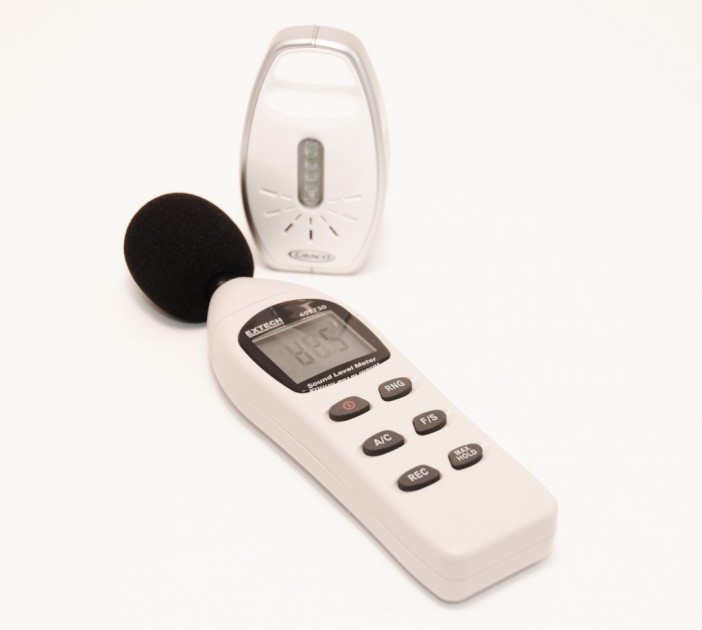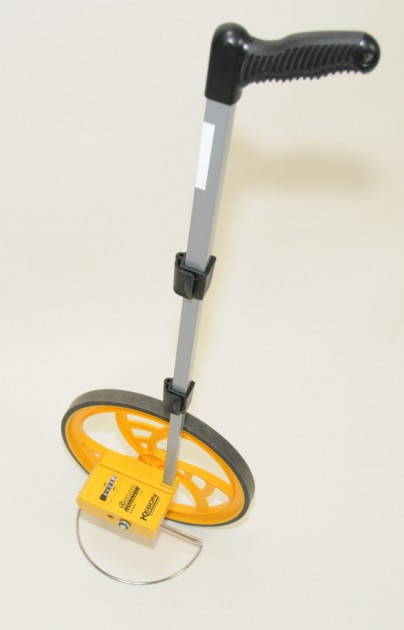We started by researching the top-rated and most popular baby monitors to see which we should include in our hands-on testing. We consider various options with different features across different price ranges. Since 2012, we've considered over 50 baby audio monitors before narrowing the finalists to put through our entire series of tests.
Baby Monitor Torture Testing
We put each baby monitor through a myriad of tests to see which performs the best. The design of our tests is to stress each monitor's capabilities objectively for range, sound quality, ease of use, features, battery life, and more. We used a combination of lab tests and real-world use to influence our ratings and opinions.
To create a controlled environment, we recorded the sound of a baby crying and background white noise from an actual nursery and created an MP3 loop that we played on an iPod. This MP3 allows us to test each monitor under identical conditions. We use an industrial sound monitor to measure sound volumes and a commercial-grade distance meter to measure open-field and indoor range tests for accuracy.
Testing Sound Clarity
It's not critical that you get crystal clear sound from your baby monitor; after all, you aren't listening to your favorite album; you want to know if your baby needs you. As long as you can hear a baby cry, your monitor works, but it's certainly nice to have clear, distortion, and static-free sound. In practice, a monitor's sound fidelity is typically degraded by static or background hiss (like a radio tuned between stations). This degradation inhibits your ability to hear your baby clearly and may limit your ability to get sleep. The sound clarity and quality vary widely between monitors. We test each monitor for both sound fidelity (does the monitor clearly reproduce the sounds in the nursery) and hiss and static.
Testing Interference
Baby monitors suffer from two primary types of signal interference. One is due to a weakening signal with more walls and a longer transmission distance. This type of interference is particularly noticeable on analog monitors or the lower-cost options where the interference can reach intolerable levels with moderate indoor obstruction (>50 feet and four walls). This problem is part of the reason we only chose digital monitors for testing. The other common source of interference is from other radio frequency devices, such as other baby monitors (perhaps a neighbor's monitor) and wireless telephones. The higher-end and digital technology monitors seem impervious to this kind of interference in our tests, automatically finding a clear channel for communication.
Testing Sound Level & Sound Activation
We used a looping MP3 track that cycled between 30 seconds of a baby crying and 30 seconds of background white noise. We placed the baby nursery unit of each monitor in one room, and 4 feet in front of it, we played that track at a standard volume setting. We used a sound meter in the room next door to measure the parent unit's maximum and minimum sound dB volume levels. Each parent unit was set to max volume for this test, and we recorded the sound level 5 inches from the monitor (that dB value is displayed in the Max Sound row of our comparison table). For those monitors with a sound activation feature, we wanted to ensure that they would activate when the baby cried but could still filter out the background noise. If they did filter out the background noise, the minimum sound was 0 dB (meaning that background noise was filtered entirely out).
Testing Ease of Use
We measured the time to set up each monitor and rated the ease of operation. We test the control features such as turning on/off, adjusting sound activation sensitivity, talk-to-baby, linking/pairing of units, etc. For the most part, the sound-only monitors are easy to set up and use.
We also consider how the various available features influenced the user experience and whether or not they improved the overall experience or made the monitor frustrating to use. Being simple isn't necessarily an asset for ease of use; being able to use the product and benefit from its features is what makes one product more natural to use over another.
Testing Range
From our point of view, some of the most important tests are those that measure range. Your baby monitor must operate in your home between the baby's room and your master bedroom. Ideally, your monitor will also work well between the baby's room and other rooms, but the master bedroom is non-negotiable. Most monitors have some range specifications listed on the box. However, we found these ranges to be unreliable at predicting actual in-home performance and wildly out of sync in some cases with our real-world experience.
Indoor Range
Indoor performance is the most important when it comes to baby monitors. While open-field range tests are fun, they don't mean anything in the real world (unless, of course, you plan to leave your baby alone in an open field, which we don't recommend). What truly matters is how the baby monitor performs inside your house, with walls, interference from other wireless devices, and the potential interference from monitors and phones from your neighbors. To test indoor range, we used a home with a unique straight-line torture-test situation where we could test each baby monitor's ability to pass through up to 8 indoor walls over a 125' long distance. This home had active WiFi networks, wireless phones, multiple cell phones, and various other wireless gadgetry providing an ideal environment to separate the weak from the signal-strong monitors. We recorded the distance and number of walls through which each monitor effectively transmitted. In some cases, the distance was limited by the monitor's ability to maintain a signal connection. In other cases, it was due to the level of interference reaching an unacceptable level.
Open Field Range
Most manufacturers provide a range specification in feet or meters that are an open-field (unobstructed) distance. We wanted to see if we could duplicate the claimed measurements in our tests. To do so, we used our baby-crying MP3 loop to play into each monitor's nursery unit. We then walked the parent unit away until it lost the signal or the interference became unacceptable.
Some competitors exceeded the manufacturer's claims, while others struggled to come close. As a result, those claims get our “pants on fire” rating for credibility.
Testing Battery Life
We test each monitor's battery life after fully charging the parent unit (or adding fresh batteries) and operating its matching nursery unit. Battery life is recorded in hours and rounded to the nearest 10th of an hour. In our experience, battery life degrades over time, and we'd expect all the monitors to need replacement rechargeable batteries within a year or so of regular use.
Testing EMF
We collected EMF values using an EMF reader at approximately 6 inches, 3 feet, and 6 feet away from the parent unit and baby device. We test monitors in the same location with equal ambient EMF to eliminate erroneous readings outside the monitors. Values were assessed by circling the units and using an average of the measurements at various points in the circle. Testing was repeated multiple times and in multiple locations to ensure reading accuracy.


